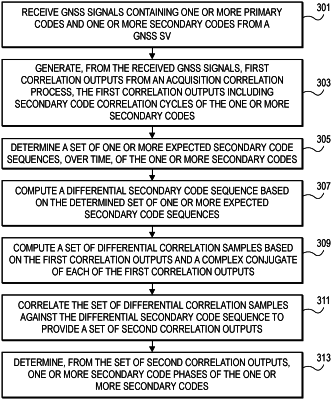| CPC G01S 19/30 (2013.01) [G01S 19/428 (2013.01); G01S 19/46 (2013.01)] | 21 Claims |

|
1. A method of operating a Global Navigation Satellite System (GNSS) receiver, the method comprising:
receiving GNSS signals containing one or more primary codes and one or more secondary codes from a GNSS satellite;
generating, from the received GNSS signals, a set of first correlation outputs from an acquisition correlation process that operates on the received GNSS signals, the first correlation outputs including secondary code correlation cycles, over time, of the one or more secondary codes;
locally generating a set of one or more expected secondary code sequences, over time, of the one or more secondary codes;
computing a differential secondary code sequence based on the locally generated set of one or more expected secondary code sequences;
computing a set of differential correlation samples based on the first correlation outputs and a complex conjugate of each of the first correlation outputs;
correlating the set of differential correlation samples against the differential secondary sequence code to provide a set of second correlation outputs;
determining, from the set of second correlation outputs one or more secondary code phases of the one or more secondary codes.
|